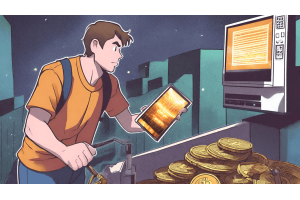A new threat to keep an eye out for has been quietly gaining momentum. It could potentially undermine the cryptographic foundations of Bitcoin, Ethereum, and almost every blockchain in existence. It is not a bug. It is not a regulation. It is quantum computing.
Quantum computing is developing rapidly, despite being in its infancy. Many of the pillars supporting today's blockchains' security may be broken if development continues at its current pace. This includes the systems responsible for validating transactions, securing private keys, and ensuring network consensus.
The crypto industry cannot afford to turn a blind eye to this threat. The choices made today will determine whether we achieve a smooth transition to quantum-resistant systems or witness a significant loss of trust across the entire ecosystem.
From “Mathematically Secure” to “Temporarily Secure”
Most blockchain networks are built on public key cryptography. Signature schemes are built on mathematical problems that are easy to verify but classically difficult to solve; specifically, factoring large integers and computing discrete logarithms. Quantum computers can solve those problems exponentially faster, meaning that systems once thought to be unbreakable might become trivial to crack, as soon as 10 to 15 years from now.
This shift is not just technical. It alters the very definition of “secure.” What once meant provably safe may soon mean safe for the time being.
Stealing the Future by Hacking the Past
The greatest quantum risk does not come from breaking into wallets in real time. It comes from the quiet collection of encrypted data today, waiting for the moment when future quantum machines can unlock it with ease. This approach, known as “harvest now, decrypt later”, turns time itself into a weapon, putting every transaction, key, and message recorded today at risk of exposure tomorrow.
Whenever a transaction is signed, the sender’s public key becomes visible. Quantum attackers could start archiving these transactions now. Once scalable quantum hardware is available, these archived keys can be decrypted making it possible to derive the corresponding private keys through quantum algorithms. Even if they have not moved for years, coins that seemed safe in cold storage could become vulnerable.
Blockchains like Ethereum and Solana may face even greater exposure. Their account based models typically associate public keys with long lived identities, making surveillance easier and more profitable over time. Without forward secrecy, compromising a single key could reveal the entire transaction history linked to it.
Cold Wallets Will Not Save You
Cold wallets are often seen as the most secure way to store cryptocurrency. However, even the most secure offline wallets must eventually sign a transaction. Once that signature is shared, the corresponding public key becomes visible.
In a world where quantum computing is possible, that single action is enough for an attacker to take advantage.
This isn’t a problem with cold storage itself, but rather a limitation of the cryptographic methods it uses. Unless these methods are updated, they will eventually be broken by quantum technology.
Post-Quantum Cryptography Is Not Plug-and-Play
There's some good news: solutions are already in the works. The U.S. National Institute of Standards and Technology has been carefully evaluating post-quantum cryptographic algorithms for quite some time. Algorithms like CRYSTALS-Kyber and Dilithium are gaining attention as strong candidates because they are designed to withstand attacks from quantum computers.
The difficulty comes from the fact that switching cryptographic techniques is not always easy, especially in decentralized networks. Bitcoin's protocol is well known for being very cautious, meaning that even small updates can lead to lengthy and debated discussions. Ethereum's move toward account abstraction offers greater flexibility, but implementing post-quantum cryptography on a large scale would still require complex migrations, contract updates, and coordination across millions of accounts.
The Cost of Connectivity
Blockchains are no longer isolated systems. As bridges, rollups, and multi-chain protocols connect them together, new vulnerabilities can emerge. If one chain is slow to implement cryptographic improvements, it can create an opening for attackers to target assets moving through the wider network.
A weak point can arise when a single chain lags in adopting cryptographic improvements, leaving it vulnerable to attackers targeting assets moving across networks. To mitigate this, trust assumptions must be considered not only at the protocol level but also across all connected components.
Validator networks add another layer of complexity. The risks grow when keys aren’t rotated often enough or get reused across epochs. In some protocols, slashing rules even discourage changing keys, which makes it harder to adapt as new threats emerge.
Why This Matters for Miners
At first glance, quantum computing may seem like a problem for wallet developers or cryptographers rather than miners. The reality is that mining only remains profitable as long as the assets being secured retain credibility and value.
If confidence in a chain’s underlying cryptography breaks, the price of its native asset could collapse. That means less revenue, fewer incentives to mine, and a breakdown in the economic engine that powers the network.
Miners do not need to understand the complex mathematics behind cryptography to recognize the risk. If the math fails, trust fails, and revenue disappears.
Preparing for the Quantum Era
No one knows the exact day quantum computers will be capable of breaking ECDSA or similar cryptographic standards. The direction of progress, however, is clear. Governments, corporations, and research institutions are investing heavily to reach that point.
The crypto industry is still early in preparing for this shift. There are clear steps available, including modular signature schemes, smarter wallet design, and protocol-level migration plans.
The chains that lead this transition will not only survive the quantum era. They will define it.






